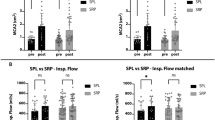Abstract
Septorhinoplasty aims to improve not only the esthetic appearance but also breathing function of the nose. Although the esthetic improvement can be judged by the patient and the surgeon easily, evaluation of nasal breathing is more complicated. Besides the subjective symptom scores given by the patient, some objective methods have been developed. One of the most widely used of these objective methods is acoustic rhinometry, which gives valuable information about the cross-sectional areas and volumes of the nasal airway as a function of distance from the nostril. Since the introduction of acoustic rhinometry, many papers were reported regarding its efficiency with some conflicting conclusions. Septorhinoplasty has the potential to narrow the nasal airway, especially if it includes lateral osteotomies and hump reduction. We aimed to evaluate the role of rhinoplasty on nasal obstruction with the help of subjective symptom scores and acoustic rhinometry. The study consisted of 26 patients who underwent septorhinoplasty. Before and after surgery, the symptom scores and findings of acoustic rhinometry were collected both before and after decongestion of the nasal mucosa. Symptom scores decreased on both sides, which were statistically significant (p < 0.05), however, the changes in cross-sectional areas of the nasal airway were not statistically significant (p > 0.05). The correlation between the symptom scores and acoustic rhinometry findings was not significant for all levels. The effect of septorhinoplasty on nasal airway and some important maneuvers to protect against nasal obstruction are discussed.
Similar content being viewed by others
References
Xavier R (2010) Does rhinoplasty improve nasal breathing? Facial Plast Surg 26:328–332
Pawar SS, Garcia GJ, Kimbell JS, Rhee JS (2010) Objective measures in aesthetic and functional nasal surgery: perspectives on nasal form and function. Facial Plast Surg 26:320–327
Erdogan M, Cingi C, Seren E, Cakli H, Kezban Gürbüz M, Kaya E, Incesulu A, Ozudogru E, Kecik C (2012) Evaluation of nasal airway alterations associated with septorhinoplasty by both objective and subjective methods. Eur Arch Otorhinolaryngol. doi:10.1007/s00405-012-1974-y
Grymer LF (1995) Reduction rhinoplasty and nasal patency: change in the cross-sectional area of the nose evaluated by acoustic rhinometry. Laryngoscope 105:429–431
Grymer LF, Gregers-Petersen C, Baymler Pedersen H (1999) Influence of lateral osteotomies in the dimensions of the nasal cavity. Laryngoscope 109:936–938
de Pochat VD, Alonso N, Figueredo A, Ribeiro EB, Mendes RR, Meneses JV (2011) The role of septal cartilage in rhinoplasty: cadaveric analysis and assessment of graft selection. Aesthet Surg J 31:891–896
Wittkopf M, Wittkopf J, Ries WR (2008) The diagnosis and treatment of nasal valve collapse. Curr Opin Otolaryngol Head Neck Surg 16:10–13
Chandra RK, Patadia MO, Raviv J (2009) Diagnosis of nasal airway obstruction. Otolaryngol Clin N Am 42:207–225
Mengi E, Cukurova I, Yalçın Y, Yiğitbaşı OG, Karaman Y (2011) Evaluation of operation success in patients with nasal septal deviation with quality of life scale and objective methods. Kulak Burun Bogaz Ihtis Derg 21:184–191
Pirilä T, Tikanto J (2009) Acoustic rhinometry and rhinomanometry in the preoperative screening of septal surgery patients. Am J Rhinol Allergy 23:605–609
Hilberg O (2002) Objective measurement of nasal cavity dimensions using acoustic rhinometry: methodological and clinical aspects. Allergy 57:5–39
Kim CS, Moon BK, Jung DH, Min YG (1998) Correlation between nasal obstruction symptoms and objective parameters of acoustic rhinometry and rhinomanometry. Auris Nasus Larynx 25:45–48
Kahveci OK, Miman MC, Yucel A, Yucedag F, Okur E, Altuntas A (2012) The efficiency of Nose Obstruction Symptom Evaluation (NOSE) scale on patients with nasal septal deviation. Auris Nasus Larynx 39:275–279
Passàli D, Mezzedimi C, Passàli GC, Nuti D, Bellussi L (2000) The role of rhinomanometry, acoustic rhinometry, and mucociliary transport time in the assessment of nasal patency. Ear Nose Throat J 79:397–400
Roithmann R, Cole P, Chapnik J, Barreto SM, Szalai JP, Zamel N (1994) Acoustic rhinometry, rhinomanometry, and the sensation of nasal patency: a correlative study. J Otolaryngol 23:454–458
Naito K, Miyata S, Saito S, Sakurai K, Takeuchi K (2001) Comparison of perceptional nasal obstruction with rhinomanometric and acoustic rhinometric assessment. Eur Arch Otorhinolaryngol 258:505–508
Kim YH, Kim BJ, Jang TY (2011) Use of porous high-density polyethylene (Medpor) for spreader or extended septal graft in rhinoplasty: aesthetics, functional outcomes, and long-term complications. Ann Plast Surg 67:464–468
Huang C, Manarey CR, Anand VK (2006) Endoscopic placement of spreader grafts in the nasal valve. Otolaryngol Head Neck Surg 134:1001–1005
Conflict of interest
The authors declare that they have no conflict of interest.
Author information
Authors and Affiliations
Corresponding author
Rights and permissions
About this article
Cite this article
Edizer, D.T., Erisir, F., Alimoglu, Y. et al. Nasal obstruction following septorhinoplasty: how well does acoustic rhinometry work?. Eur Arch Otorhinolaryngol 270, 609–613 (2013). https://doi.org/10.1007/s00405-012-2102-8
Received:
Accepted:
Published:
Issue Date:
DOI: https://doi.org/10.1007/s00405-012-2102-8




